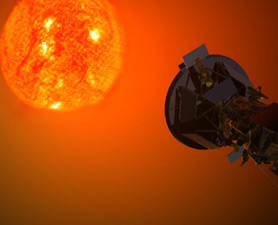 |
Flying into the sun's corona is suicidal to be sure, but
scientists want to find out how the sun's atmosphere is heated. |
Flying into the sun's corona is suicidal to be sure, but scientists want to find out how the sun's atmosphere is heated.
Why the sun's atmosphere is nearly 200 times hotter than its visible surface is a long-standing mystery. A new spacecraft, called Solar Probe Plus, aims to find some answers.
Flying directly into the sun's corona is a suicidal mission to be sure, but scientists and engineers at the Johns Hopkins University Applied Physics Lab in Baltimore, which is developing Solar Probe Plus for NASA, plan to keep the spacecraft alive as long as possible.
It's not going to be easy. For starters, the probe will need to withstand temperatures up to about 2,600 degrees Fahrenheit. Plus, its heat shield can't ablate, or boil away like the shields on capsules returning through Earth's atmosphere are designed to do. That would pollute the particles and measurements Solar Probe Plus is being dispatched to gather.
"The whole point of the mission is to do particle detection and in situ measurements. If you're measuring part of your shield that's not going to work," Andy Dantzler, Solar Probe Plus project manager at
The spacecr aft also needs to be extremely lightweight so that it can fly.
aft also needs to be extremely lightweight so that it can fly.
"You need a lot of speed to go against the direction of the Earth," said Dantzler.
Eight weeks after launch, Solar Probe Plus will arrive at the sun to begin the first of 24 orbits using flybys of Venus to gradually shrink its distance to the sun. Eventually, it will come as close as about 4 million miles, which is inside the orbit of Mercury and about eight times closer than any previous spacecraft.
NASA is in the process of reviewing proposals for instruments to be included on the probe, but the overall mission goals are to figure out the sun's heating mechanism and determine how it whips up the solar wind -- the continuous blast of charged particles that permeate the solar system and define its boundaries.
"We want to know what it is that accelerates the plasma," Dantzler said. "We know it has to do with magnetic fields, but we don't really know how that comes about."
Various incarnations of Solar Probe Plus have been at the top of solar physicists' wish lists for more than 50 years, but until recently the technical problems exceeded the available budget to solve them.
"Solar Probe will be an extraordinary and historic mission, exploring what is arguably the last region of the solar system to be visited by a spacecraft," a NASA science oversight team headed by David McComas with the Southwest Research Institute in Texas, wrote in a report recommending the mission.
In addition to answering some basic science questions, information gathered by Solar Probe Plus could have some practical impacts by helping to improve space weather forecasts. Solar storms and magnetic disturbances from the sun can disrupt satellites and radio transmission, as well as take out power grids on Earth.
"Right now, predicting space weather is kind of like trying to predict hurricanes without knowing the acceleration effects of the oceans. Without that, you really can't understand them at all," Dantzler said.
Solar Probe Plus, which will cost more than $1 billion, initially was to launch in 2015, but has been bumped to 2018 to spread out the cost. NASA is expected to select the probe's science instruments this month.

 Previous page
Previous page Back to top
Back to top







